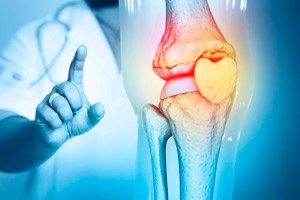
All iLive content is medically reviewed or fact checked to ensure as much factual accuracy as possible.
We have strict sourcing guidelines and only link to reputable media sites, academic research institutions and, whenever possible, medically peer reviewed studies. Note that the numbers in parentheses ([1], [2], etc.) are clickable links to these studies.
If you feel that any of our content is inaccurate, out-of-date, or otherwise questionable, please select it and press Ctrl + Enter.
Acupressure for Osteoarthritis: How to Block Pain and Inflammation Through Ion Channels
Last reviewed: 09.08.2025
 ">
">Osteoarthritis (OA) affects hundreds of millions of people, causing destruction of joint cartilage, inflammation, and chronic pain. Until now, all available drugs only alleviate symptoms without stopping the pathogenesis. A new review in Trends in Pharmacological Sciences summarizes the growing evidence that membrane ion channels are at the “epicentre” of processes governing chondrocyte life and pain perception, and therefore represent key therapeutic targets.
The main "players" and their roles
Nav1.7 (sodium channel)
Expressed on nociceptors in synovium and around cartilage.
Enhances the transmission of pain signals from the joint to the spinal cord.
Precision Nav1.7 blockers already demonstrate powerful analgesia without general anesthesia at preclinical stages.
TRP channels (TRPV1, TRPA1, etc.)
They sense physical and chemical irritants (temperature, oxide mediators).
Their reconfiguration in OA leads to hypersensitivity of pain receptors.
TRPV1 antagonists reduce synovial pain and swelling in an osteoarthritis model.
Piezo1/2 (mechanosensory channels)
Critical for mechanotransduction in chondrocytes: respond to compression and stretching of cartilage, regulate Ca²⁺ entry.
With chronic overload of synovial fluid, their overactivation triggers a cascade of calcium stress, leading to chondrocyte apoptosis.
Piezo inhibitors protect cartilage and improve mobility in preclinical studies.
P2X receptors (P2X3, P2X7)
Ligand-gated ion channels activated by extra- and intracellular ATP.
ATP aggregation in the inflamed joint provokes prolonged nociception and the release of proinflammatory cytokines via P2X7.
Monoclonal antibodies against P2X7 reduce swelling and inflammatory markers in cartilage.
ASIC (acid-sensing ion channels) and chloride channels
A local decrease in pH is recorded in inflamed joints, which increases pain.
Modulation of their activity normalizes intracellular pH and prevents matrix degradation.
Therapeutic strategies
- Small molecule blockers: Many of these have already entered the preclinical phase, showing pain reduction, cartilage loss and inflammation in rat and rabbit models.
- Biological agents: antibodies and biological "disruptor" fragments target unique allosteric sites on the channels while maintaining normal physiology in other tissues.
- Gene therapy: Using AAV vectors or lipid nanoparticles to deliver siRNA or CRISPR/Cas9 constructs aimed at reducing the expression of harmful ion channels directly in chondrocytes.
- Repositioning: Already licensed drugs for lung or neurological diseases that target identical channels are tested in OA patients, accelerating clinical trials.
Problems and solutions
Selectivity
- Many channels are also present in other tissues (nerve, cardiomyocytes).
- Solution: local delivery (gels, implants) and controlled release through pH- and enzyme-sensitive carriers so that the drug acts only in the joint cavity.
Patient-centered therapy
- OA is a heterogeneous disease: in different patients, mechanotransduction, inflammation or nociception dominate.
- Solution: Biomarker screening (detection of increased expression of a specific channel in the synovium) to stratify patients and prescribe the most appropriate blocker.
The authors highlight four key points:
The Central Role of Ion Channels in the Pathogenesis of OA
“We have shown that not only inflammation and mechanical abrasion, but also the distortion of Nav1.7, TRP and Piezo channels directly affects chondrocyte survival and pain perception,” notes the lead author of the review.Potential for selective modulation
“Small molecules and allosteric antibodies targeting specific channel subtype variants have already demonstrated inhibition of cartilage degradation without systemic side effects in preclinical models,” emphasizes co-author Dr. I. Kim.Repositioning existing drugs
“Drugs developed for neurology (Nav1.7 blockers) or pulmonary hypertension (TRP channel modulators) can be quickly translated into the OA clinic, which will significantly accelerate the emergence of new therapies,” adds Dr. A. Patel.The need to stratify patients
“OA can be ‘mechanotransductive’, ‘inflammatory’ or ‘nociceptive’ – it is important to identify which channels predominate in a particular patient in order to prescribe targeted inhibitors and achieve maximum efficacy,” summarizes Dr. S. Lee.
Prospects
According to the authors of the review, a combined approach — simultaneous targeting of several key channels — can provide more complete relief of symptoms and slow down the progression of osteoarthritis. In addition, the development of precision medicine for OA based on ion channels promises personalized “smart” drugs that can not only “turn off” pain, but also maintain the viability of cartilage cells with minimal systemic effects.
